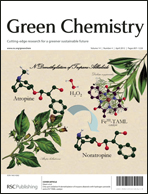Entrainer-intensified vacuum reactive distillation process for the separation of 5-hydroxylmethylfurfural from the dehydration of carbohydrates catalyzed by a metal salt–ionic liquid†
Abstract
As more and more novel catalyst systems are being developed for the dehydration of carbohydrates, especially glucose, an effective way to separate the dehydration product 5-hydroxylmethylfurfural (5-HMF) is also required for industrial manufacturing. In this paper, for the first time, we have developed a process called EIVRD (entrainer-intensified vacuum reactive distillation) to separate 5-HMF from the dehydration solutions of carbohydrates catalyzed by a metal chloride/1-methyl-3-octyl imidazolium chloride ([OMIM]Cl) ionic liquid, in which high vacuity and entrainers were applied to intensify the distillation of 5-HMF as well as the dehydration of fructose or glucose. In such an EIVRD process, the average recoveries of 5-HMF dehydrated from fructose and glucose are around 93% and 88%, respectively. The recycling of the catalyst system in the EIVRD process is so convenient that the recovery and actual yield of 5-HMF is successfully repeated during the whole five recycled reactions.


 Please wait while we load your content...
Please wait while we load your content...